This was published 7 years ago
Ethiopia, Africa travel guide: The amazing country that no longer wants to be kept secret
By Sue Williams
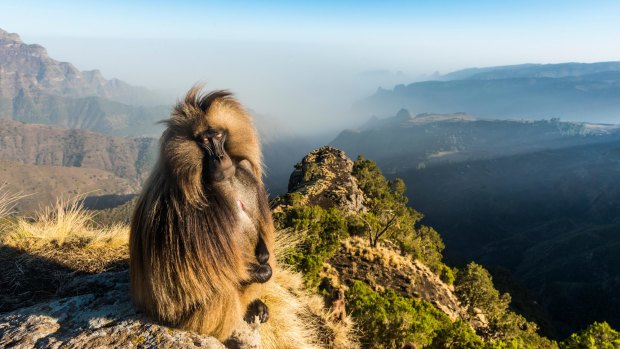
Male Gelada sitting on a cliff, Simien Mountains National Park.Credit: Alamy
Ethiopia was once one of the least welcoming places in the world. With its proud peoples, an ancient history – arguably being the birthplace of humanity following the discovery of the 3.2 million-year-old skeleton dubbed "Lucy" – and a fiercely independent Abyssinian royalty, including the legendary Queen of Sheba, it was the only country in Africa never to be colonised.
But today Ethiopia's doors to the outside world are open like never before. "We want to show everyone what an amazing country we have," says local guide Gebresilassie Haddis. "We don't want to keep it a secret anymore."
The world is listening with the landlocked country on the Horn of Africa named on many lists as one of the places to visit in 2018. Lonely Planet named it Africa's number one destination and an increasing number of travel companies are scrambling to add itineraries.

The 3.2 million-year-old skeleton dubbed "Lucy".Credit: Alamy
In January, when I visited on a 10-day tour, operated by Peregrine, the Ethiopian Government further enhanced the re-emerging destination's appeal by signalling a new political liberalisation and lifting a ban on social media.
Echoes of a dark past, however, still resonate. It was once better known in the west as a place of terrible drought and famine, which inspired Bob Geldof's Band Aid in 1984 to raise funds to help, and later Live Aid. Fortunately, Ethiopia's record in maintaining the health of its people has since improved, though much remains to be done.
Physically, Ethiopia is stunning. The Great Rift Valley tears through the length of the country, creating magnificent mountains, breathtaking gorges and dramatic valleys, giving Ethiopia its moniker, "The Roof of Africa". It's also home to the Blue Nile, that feeds into the Nile, the longest river on earth.
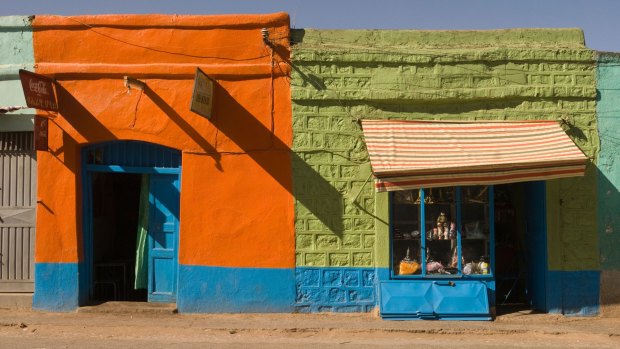
Harar, Ethiopia.Credit: Alamy
There are several scenic national parks with wildlife not seen anywhere else on earth, like the Gelada baboon with its scarlet splash by its heart, the handsome walia ibex and the coyote-like Ethiopian wolf.
At the same time, despite the terrain, Ethiopia is the second-most populous nation in Africa, behind Nigeria and just ahead of Egypt. Ethiopia's religions are composed of Christians, Muslims and Animist. Its population is diverse and divided into no fewer than 80 different ethnic groups, some of which are astoundingly colourful and remarkable in both their costume and body decoration.
The Mursi women of the south, for instance, wear huge ceramic plates in their lower lip while painting their entire bodies with white ochre. Others are devout members of the Ethiopian Orthodox Church, which began at the dawn of Christianity and predates all the churches of Europe.
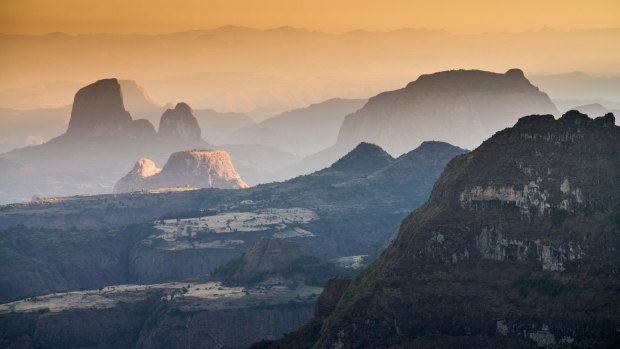
Simien Mountains National Park.Credit: Alamy
The north of the country, as a result, has a vast number of striking World Heritage-protected rock-hewn churches from the 11th and 12th centuries, and monasteries.
There are also the remains of incredible medieval forts, burial chambers and palaces. Because, after all, Ethiopia also boasts one of the longest-running royal dynasties in the world, dating back to around 10BC when Sheba visited King Solomon of Israel and, as legend has it, gave birth to the country's first king.
That imperial line lasted all the way to 1974 when descendant Emperor Haile Selassie, aka Conquering Lion of the Tribe of Judah, King of Kings and Elect of God, was deposed in a military coup. These days, Ethiopia is a republic, with a president, but enough of the history. The best way to experience today's re-emerging Ethiopia and myriad wonders, of course, is on an escorted journey beginning in the capital.
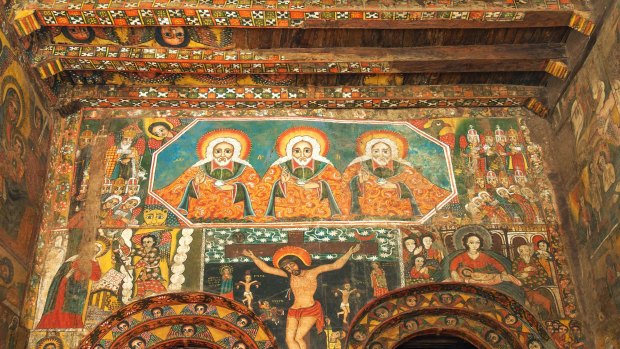
Paintings inside an ancient church in Gondar, Ethiopia.Credit: Alamy
HIGH TIME: THE CAPITAL, ADDIS ABABA
Just a 3½-hour flight from Dubai, Addis Ababa, one of the world's highest capitals at 2355 metres above sea-level, is a sprawling metropolis that never quite looks like a modern city.
Instead, it feels frozen in the 1950s with prosaic old shopping centres, roads on which stray goats, sheep, cows and donkeys still wander, and broken pavements.
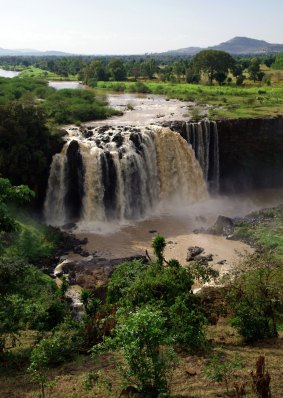
Blue Nile Falls, Ethiopia.Credit: Alamy
Yet it is an important place, not only as the hub of the country but also as the capital of the entire continent in keeping with Ethiopia's honorary title "Mother of all African countries".
In addition, it's home to the headquarters of the Pan-African organisation the African Union, and the United Nations Economic Commission for Africa. There are also plenty of landmarks of its past. In the National Museum, I pay my respects to the remains of our ancestor, Lucy – surprisingly short and squat – who rewrote history on the origins of humankind with her discovery in 1974.
Then, in the magnificent Holy Trinity Cathedral, I say farewell to Haile Selassie and his wife Empress Menen Asfaw, with a viewing of their great granite tombs sitting side by side. He could never be considered a humble man, however. High on the wall is a glorious painting of baby Jesus in Mary's arms – with Selassie standing proprietorially on her right, and Asfaw on her left.
More sombre is the "Red Terror" Martyrs' Memorial Museum, portraying life after the coup and Selassie's murder. The Communists took power and an estimated 500,000 people were slain in a series of purges of enemies of the state in a terrible 17-year reign. A further million died from the famine.
Elsewhere, the capital, a cheerfully ramshackle place, is punctuated by towering monuments such as the intimidatingly huge marketplace – the biggest in all Africa. And there's the spiritual home of long-distance running, Meskel Square, jammed not only with joggers but also some fine restaurants and clubs with traditional dance.
TRAVELLING NORTH: BAHIR DAR
It's an early start this morning with a short flight on Ethiopian Airlines, perhaps surprisingly one of the best airlines in Africa, to Bahir Dar, considered the Riviera of Ethiopia. It's a pretty, lush green town on the shores of the picturesque Lake Tana, the source of the Blue Nile.
Already I'm starting to slow down, conforming to the more relaxed pace of this compelling country. People regularly stop to say hello and have a leisurely chat with some attributing the civility to Ethiopia never having been being colonised by a foreign power – visitors are treated more as honoured guests rather than former invaders.
A cruise around a part of the 3500-square-metre lake is a must, visiting one or more of the 37 islands, many of which house monasteries from the 13th and 14th centuries. We stop at the island site of the monastery of URA-Kidnae Mehret and walk along the winding path through the forest, swinging with monkeys, to what looks, from the outside, an unremarkable building. Inside, however, it's simply astonishing.
The walls are lined with beautiful painted scenes from the Bible, and morality stories for those worshippers who couldn't read. The next day, there's another treat in store, this time a drive, then scenic walk, to the Blue Nile Falls, more than 400 metres wide and crashing 48 metres down when in full flood.
The sight apparently used to be even more impressive before the construction of what's set to be the continent's most ambitious, and controversial, hydro-electric power-generating station. Yet it is still comparable with the other great falls of the world – South America's Iguazu, Zimbabwe and Zambia's Victoria Falls and Niagara in the US – and the children who gather to hold tourists' hands along the way can be just as entertaining.
HOMAGE TO THE ANCIENT CAPITAL: GONDAR
Driving north around the lake the next day, there are scenes being enacted of everyday life unchanged from biblical days. Farmers lead oxen around in a continuous circle to thresh grain, crushing the millet to separate it from the chaff. Donkeys plod the roads – and apparently Ethiopia has more donkeys per head of population than another other country on earth – dwarfed by enormous bundles of hay.
Children carry massive loads of animal dung to villages to make running repairs on huts. And women walk to wells to collect water, bringing it back skilfully balanced on their heads. I feel awed to be witnessing lives that look barely changed over the past 2000 years.
We arrive 4½ hours later at Gondar, the capital of Ethiopia in the 17th and 18th centuries, and famed for its medieval castles and churches. The Debre Berha Selassie Church, surrounded by towering juniper trees, again has beautiful biblical scenes painted on to material on the walls and the ceiling is covered with gorgeous doe-eyed Ethiopian angels.
A WALK ON THE WILD SIDE: SIMIEN MOUNTAINS NATIONAL PARK
Our 11-strong, all-Australian Peregine group is a varied one and includes a miner now working as an expat in Eritrea and his family, a couple with a lime orchard, a retired West Australian farmer, and an older former nurse who had more energy than some of us 20 years younger. We set off early for a three-hour drive from Gondar to Simien Mountains National Park, one of Africa's genuine beauty spots.
Often compared with the Grand Canyon, this park of craggy peaks, towering ridges and panoramic views over the surrounding countryside is almost another world.
Rugged and dramatic, with Ethiopia's highest peak Ras Dejen and swathes of brightly coloured wildflowers and giant baobabs, there are also continual surprises. I was only 10 minutes into a walk when suddenly I was surrounded by dozens of Gelada baboons, the area's distinctive shaggy breed with red over their heart.
Unafraid of humans, they gambol, play, pick nits out of each other's fur, fight and dig at roots to eat, completely unbothered by your presence
The country is also a major bird-watching destination with more than 800 species, of which an astonishing 37 are endemic, or near-endemic.
After the trek, there's a brand new eco-hotel to retire to, the beautiful Limalimo Lodge, built by two former park guides, along with local villagers who now also staff the place. Together, they've planted 50,000 native trees on the site too.
Even leaving the next morning is one hell of a ride along one of the world's most spectacular roads, a series of breathtaking switchbacks built by the Italians during their ill-fated attempt at occupation, with continual glimpses of the River Tigray far below.
THE CROSSROADS OF THE WORLD: AXUM
Our next stop is Axum, which was once an incredibly important trading post between east and west, trading with the Roman empire, the Turks, Indians and Saudi Arabia.
Here is also the site of the first Christian church in black Africa, the St Mary of Zion Church, which is believed to house the most fabled biblical relic in history – the Ark of the Covenant. That's never, however, been officially confirmed; only a few guardians are ever allowed to gaze on it with anyone else who tries damned with a terrible fate.
The town is dominated by more than 100 towering stele, massive carved granite columns, carried into position by elephants and erected as tomb markers to signal the importance and power of each of the former kings. The biggest stands at 33 metres, and weighs more than 517 tonnes.
Just out of town there are the remnants of the Queen of Sheba's palace, a tremendously atmospheric site that enables you once again to appreciate the power and the glory of this old kingdom. The town only fell in significance when the Persians conquered part of the kingdom, now Yemen, it lost control of the Red Sea and a new religion arrived, Islam.
CITY OF CHURCHES: LALIBELA
We rise early after two nights in Axum for a two-hour flight to Lalibela, our final stop on our tour, isolated in the Lasta Mountains, yet the home of one of the world's most spellbinding collection of historical religious sites.
It is to these that pilgrims flood every Christmas – on January 7 as the country runs on a solar calendar derived from the Egyptian calendar – as one of the holiest places of the holy.
And, when you see them, it's little surprise. Between the 12th and 13th centuries, a series of 11 fabulous churches were hewn from the rocks, created, remarkably, from single pieces of stone beneath the earth. Still today, no one knows quite how they managed such a feat. It's one of the great wonders of the world.
Our trip coincided with the Ethiopian Christmas, and pushing your way through thousands of white cloth-draped worshippers, all keen to help you up and down the rocks on the winding pathways into the respective churches, was one of the most memorable experiences of my life.
The churches themselves are incredible – the stunning views of them from the ground above, the atmospheric walks down, the cool carved interiors, the magnificent decor – and the people keeping the heritage alive and vibrant today are mesmerising.
The most massive church, the 787 square metre Bet Medhane Alem, is actually three in one connected by courtyards and tunnels and with plenty of viewing platforms from above. The best known, however, is probably Bet Giyorgis, carved in the form of a Greek Cross, while there are also rock churches and monasteries perched high on mountaintops surrounding the town.
It's Ethiopia's most splendid town imaginable, and a fitting highlight before the late morning flight back to Addis Ababa.
FIVE ESSENTIAL ETHIOPIAN EXPERIENCES
CATCHING A FESTIVAL
Ethiopia is a country of festivals, so try to coincide your visit with a festival such as Leddet (Christmas in January), Timkat (Epiphany, also in January), Meskel (September), or the Great Ethiopian Run (November).
A COFFEE CEREMONY
As the birthplace of what's become the world's second most valuable trading commodity after petrol, coffee is a cornerstone of Ethiopian life. Sit as a coffee seller roasts the beans, fanning the fumes towards you for good luck, and painstakingly makes thick sweet coffee on a tiny burner.
EATING THE NATIONAL DISH, INJERA AND WAT
As the ubiquitous favourite meal eaten three times a day, you can't avoid it. The injera is a massive, thick, spongy, pretty tasteless pancake on top of which is dolloped a spicy stew of either chickpeas or meat. Eat with the right hand only.
WATCHING TRADITIONAL DANCE
Ethiopia has some of the weirdest dance moves on the planet. A favourite is a violent hair-tossing, head-spinning, neck-whipping dance that brings tears to the eyes of the watchers … Surely, you think, that must really hurt.
GOING FOR A RUN
Ethiopians are world-class long distance runners so if you can't beat them, join them. Go for a run in Meskel Square in Addis Ababa, and try to look nonchalantly as though you never planned to go terribly fast as you're passed by young and old alike.
FIVE MORE PLACES TO VISIT IN ETHIOPIA AND BEYOND
LOWER OMO VALLEY
The home of some of the most incredibly colourful tribes on earth, including the Mursi with ceramic plates in the lower lips of the women, and the Hamer, with their red ochred hair.
TIYA ARCHAEOLOGICAL SITE
Here 36 prehistoric rock art monuments dot the landscapes, left by a still unknown ancient civilisation.
HARAR
Inside the old city walls of Harar are numerous museums, traditional homes and monuments, while hand-fed hyenas wander through the streets.
KAFA BIOSPHERE RESERVE
Visit the coffee museum to learn the story of how coffee was first discovered in Ethiopia by a goatherder who noticed his animals were particularly frisky after eating the red berries.
DJIBOUTI
If you're missing the sight of the sea from landlocked Ethiopia, this pretty country, colonised by the Italians, offers great diving, snorkelling and swimming with whale sharks.
TRIP NOTES
TOUR
Peregrine offer a range of tours throughout the country. One of the most popular is the 10-day Highlights of Ethiopia, around the historic northern circuit, costing from $4830 a person twin-share. There are also tours of the south, and longer tours of the whole country. See peregrineadventures.com
VISIT
Visas are issued to Australian citizens on arrival in Ethiopia. There are plenty of ATMs around Addis and in most of the major towns but credit cards are rarely accepted. Take American dollars to change when you don't have the local currency, the Birr. For prevailing travel conditions in Ethiopia visit the Australian Government's Smart Traveller website. See smartraveller.gov.au
FLY
There are a number of airlines, including Emirates and Ethiopian Airlines, that fly into Addis Ababa. Ethiopian Airlines also have a comprehensive series of internal flights to avoid the sometimes long drives on poor roads if you don't have the time. See ethiopianairlines.com
STAY
There are lots of cheap hotels, a growing number of mid-range hotels and only a few top places to stay outside Addis. Electricity in some of them can be erratic. The mobile phone network is getting stronger by the week, and there's often Wi-Fi offered in hotels.
Sign up for the Traveller Deals newsletter
Get exclusive travel deals delivered straight to your inbox. Sign up now.